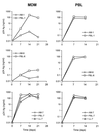Patterns of chemokine receptor fusion cofactor utilization by human immunodeficiency virus type 1 variants from the lungs and blood
- PMID: 10400765
- PMCID: PMC112752
- DOI: 10.1128/JVI.73.8.6680-6690.1999
Patterns of chemokine receptor fusion cofactor utilization by human immunodeficiency virus type 1 variants from the lungs and blood
Abstract
Human immunodeficiency virus type 1 (HIV-1) infection is highly compartmentalized, with distinct viral genotypes being found in the lungs, brain, and other organs compared with blood. CCR5 and CXCR4 are the principal HIV-1 coreceptors, and a number of other molecules support entry in vitro but their roles in vivo are uncertain. To address the relationship between tissue compartmentalization and the selective use of entry coreceptors, we generated functional env clones from primary isolates derived from the lungs and blood of three infected individuals and analyzed their use of the principal, secondary, orphan, and virus-encoded coreceptors for fusion. All Env proteins from lung viruses used CCR5 but not CXCR4, while those from blood viruses used CCR5 or CXCR4 or both. The orphan receptor APJ was widely used for fusion by Env proteins from both blood and lung viruses, but none used the cytomegalovirus-encoded receptor US28. Fusion mediated by the secondary coreceptors CCR2b, CCR3, CCR8, and CX3CR1 and orphan receptors GPR1, GPR15, and STRL33 was variable and heterogeneous, with relatively broad utilization by env clones from isolates of one subject but limited use by env clones from the other two subjects. However, there was no clear distinction between blood and lung viruses in secondary or orphan coreceptor fusion patterns. In contrast to fusion, none of the secondary or orphan receptors enabled efficient productive infection. These results confirm, at the level of cofactor utilization, previous observations that HIV-1 populations in the lungs and blood are biologically distinct and demonstrate diversity within lung-derived as well as blood-derived quasispecies. However, the heterogeneity in coreceptor utilization among clones from each isolate and the lack of clear distinction between lung- and blood-derived Env proteins argue against selective coreceptor utilization as a major determinant of compartmentalization.
Figures






Similar articles
-
Use of GPR1, GPR15, and STRL33 as coreceptors by diverse human immunodeficiency virus type 1 and simian immunodeficiency virus envelope proteins.Virology. 1998 Sep 30;249(2):367-78. doi: 10.1006/viro.1998.9306. Virology. 1998. PMID: 9791028
-
Coreceptor usage of BOB/GPR15 and Bonzo/STRL33 by primary isolates of human immunodeficiency virus type 1.J Gen Virol. 1999 May;80 ( Pt 5):1241-1251. doi: 10.1099/0022-1317-80-5-1241. J Gen Virol. 1999. PMID: 10355771
-
Utilization of chemokine receptors, orphan receptors, and herpesvirus-encoded receptors by diverse human and simian immunodeficiency viruses.J Virol. 1997 Dec;71(12):8999-9007. doi: 10.1128/JVI.71.12.8999-9007.1997. J Virol. 1997. PMID: 9371556 Free PMC article.
-
Chemokine receptors and virus entry in the central nervous system.J Neurovirol. 1999 Dec;5(6):643-58. doi: 10.3109/13550289909021293. J Neurovirol. 1999. PMID: 10602405 Review.
-
Chemokine receptors as HIV-1 coreceptors: roles in viral entry, tropism, and disease.Annu Rev Immunol. 1999;17:657-700. doi: 10.1146/annurev.immunol.17.1.657. Annu Rev Immunol. 1999. PMID: 10358771 Review.
Cited by
-
Pulmonary infections in the HIV-infected patient in the era of highly active antiretroviral therapy: an update.Curr Infect Dis Rep. 2007 May;9(3):228-32. doi: 10.1007/s11908-007-0036-x. Curr Infect Dis Rep. 2007. PMID: 17430705
-
An unusual syncytia-inducing human immunodeficiency virus type 1 primary isolate from the central nervous system that is restricted to CXCR4, replicates efficiently in macrophages, and induces neuronal apoptosis.J Neurovirol. 2003 Aug;9(4):432-41. doi: 10.1080/13550280390218706. J Neurovirol. 2003. PMID: 12907388
-
CCR8 on human thymocytes functions as a human immunodeficiency virus type 1 coreceptor.J Virol. 2000 Aug;74(15):6946-52. doi: 10.1128/jvi.74.15.6946-6952.2000. J Virol. 2000. PMID: 10888633 Free PMC article.
-
Variability in the human immunodeficiency virus type 1 gp120 Env protein linked to phenotype-associated changes in the V3 loop.J Virol. 2002 Apr;76(8):3852-64. doi: 10.1128/jvi.76.8.3852-3864.2002. J Virol. 2002. PMID: 11907225 Free PMC article.
-
Evidence for limited genetic compartmentalization of HIV-1 between lung and blood.PLoS One. 2009 Sep 14;4(9):e6949. doi: 10.1371/journal.pone.0006949. PLoS One. 2009. PMID: 19759830 Free PMC article.
References
-
- Agostini C, Trentin L, Zambello R, Semenzato G. HIV-1 and the lung. Infectivity, pathogenic mechanisms, and cellular immune responses taking place in the lower respiratory tract. Am Rev Respir Dis. 1993;147:1038–1049. - PubMed
-
- Alimohammadi A, Coker R, Miller R, Mitchell D, Williamson J, Clarke J. Genotypic variants of HIV-1 from peripheral blood and lungs of AIDS patients. AIDS. 1997;11:831–832. - PubMed
-
- Alkhatib G, Liao F, Berger E A, Farber J M, Peden K W C. A new SIV co-receptor, STRL33. Nature. 1997;388:238. - PubMed
-
- Ayehunie S, Garcia-Zepeda E A, Hoxie J A, Horuk R, Kupper T S, Luster A D, Ruprecht R M. Human immunodeficiency virus-1 entry into purified blood dendritic cells through CC and CXC chemokine coreceptors. Blood. 1997;90:1379–1386. - PubMed
Publication types
MeSH terms
Substances
Grants and funding
LinkOut - more resources
Full Text Sources
Molecular Biology Databases

